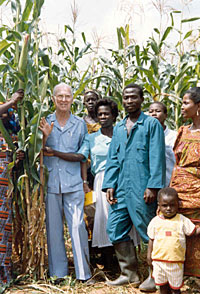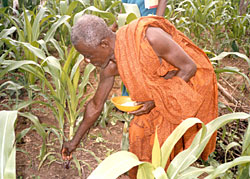The Carter Center's Agriculture Program worked in 15 sub-Saharan African countries between 1986-2011.
Farming is a precarious business anywhere in the world. Besides the supply/demand factors that affect any business, farmers face the fickleness of Mother Nature.
In developing countries, farmers contend with even more daunting challenges. Because there are few farm supply stores in most of western and central Africa, farmers must travel a day or more to buy seed, fertilizer, and herbicides for weed control. Fertilizer costs three to four times more than in developed countries. Few farmers can get loans to buy these input supplies.
Those who overcome the odds to produce good crop yields can't count on profitability. Poverty prevents buyers from paying much for the grain, and poor roads keep the grain from reaching larger markets. Unlike developed countries, most African farmers have no way to store grain. Therefore they must sell when prices are lowest immediately after harvest.
Farmers are very concerned about feeding themselves and their families. But there is an even more monumental challenge: keeping many thousands of others in their countries from dying of starvation and malnutrition.
On the positive side, increasing numbers of farmers are benefiting from assistance by a partnership of the Carter Center's Global 2000 program and the Sasakawa Africa Association (SG2000). SG2000 has shown farmers in 15 sub-Saharan African countries improved techniques that double or triple their crop yield.
"The power of technology to improve the lives of people is readily evident," claims Dr. Wayne Haag, who has worked in the SG2000 program for 13 years, "especially in countries like Ghana, where other parts of the support system fall into place after the farmers' success. It's very pleasing to see former subsistence farmers become truly commercial farmers and build better, more permanent homes."
Technology doesn't mean mechanization. It means improved methods of farming and quality seeds, fertilizers, and herbicides.
When SG2000 began its work in Ghana, no seed companies existed. "We started organizing seed growers," Dr. Haag says. "Eventually, small commercial companies emerged out of these groups, and they have become profitable." Most required SG2000 support, in the form of staff training, gaining access to seed of varieties that work best in their areas, and advice about storage, packaging, selling, and distributing.
"To make the system sustainable," he adds, "it's important that the seed be sold, not given away. We gained the confidence of rural banks and other lending institutions and encouraged them to issue loans to farmers' who were committed to our proven high-yielding production technology." Last year, banks recovered 100 percent of these loans.
In Uganda, government support of agriculture and SG2000's work has helped farmers achieve bumper harvests. More than 14,000 small-scale farmers were trained in SG2000 techniques. The greater yields pushed prices lower, however, which has had the long-term positive effect of prompting the government to find markets outside the country.
Besides higher production, another stimulant to attracting needed investment for farmer support systems is the introduction in recent years of an improved maize. It's called Quality Protein Maize because its protein has twice the nutrient value of traditional maize - about 90 percent of the nutritional value of milk, which is prohibitively costly.
QPM is gaining increasing acceptance as an infant weaning food and as livestock feed. Children fed baby food made from QPM rather than regular maize grow at more normal rates and are less likely to get sick.
"We have a long way to go, though, in promoting greater use of QPM," Dr. Haag says. "It's a bit like selling iodized salt. People have to be convinced it's better for them."
That said, QPM has the potential of being a kind of silver bullet to stimulate greater attention to agriculture, he believes. To achieve that potential, QPM's value has to be promoted on both ends of the supply/demand chain.
"If we can convince a big consumer such as the World Food Program to buy QPM, for example," he says, "the big seed companies may be encouraged to produce more QPM seed. Once they put their marketing resources to selling it, donors and other investors may be more willing to fund businesses to support farmers - rural input dealers, grain storage facilities, local food processors, and access to other markets."
Learn more about the Carter Center's Agriculture Program.
 |
CARTER CENTER PHOTO Nobel Peace Prize Laureate Norman Borlaug, Ph.D., in Ghana with farm family and their SG 2000 maize crop. |
 |
SASAKAWA-GLOBAL 2000 PHOTO Lord Della-Braunnes, an agricultural extensionist in the Volta region of Ghana, conducts a hilltop training session with SG 2000 farmers. |
 |
SASAKAWA-GLOBAL 2000 PHOTO A village chief learns how to apply fertilizer in an SG 2000 training program. |
Please sign up below for important news about the work of The Carter Center and special event invitations.